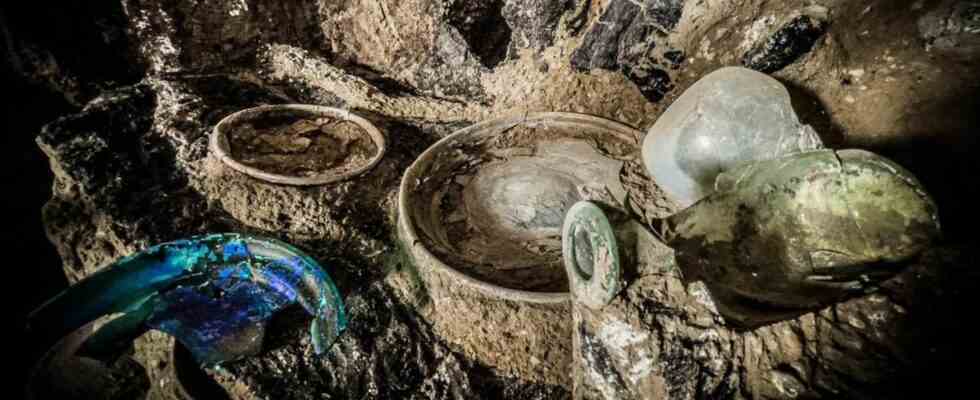volcano eruption
Pompeii – the House of Spirits shows the life of middle-class citizens
Some of the household items are still surrounded by the ashes.
© dpa
The House of Ghosts has a magnificent and representative inner courtyard. However, the owners have not yet been able to decorate the living quarters. Her house shows the will to rise of the little people in the empire.
The eruption of Versuvius in AD 79 preserved the two coastal cities of Herculaneum and Pompeii in a time capsule. The lava ash covered and protected the remains of the cities for almost 2000 years. So far, the large, magnificent villas have often been excavated and admired. Recently, archaeologists are also turning their attention to the “little” people. The House of Crafts and the recently shown street snack bar are well known. In a house that was first excavated in 2018, valuable details from the life of ordinary citizens have now been discovered. The inner courtyard, the “enchanted” garden, is the jewel of the house. Its walls are decorated with frescoes. In the back there is a large shrine for the Lares, the house spirits. Because of him, the building is also called the house of spirits.
The beautiful sparkle
The courtyard is the most representative part of the building. “The owners were able to furnish the courtyard, which housed the Lares shrine and a fountain, with excellent paintings, but obviously they didn’t have enough money for their rooms,” said the park’s director, Gabriel Breeding bar. “We don’t know who lived here, but the rich life portrayed in the courtyard seems to have been more their wish than everyday reality.” In this courtyard, the residents could present themselves and receive visitors, in the building itself things are more modest.
Breeding bar is interested in the “normal” citizens of the city and the slaves. The new excavations then also tell stories from the life of the town’s petty bourgeoisie. “These people often lived in rented apartments and were on the fringes of the wealthier classes. In the Roman Empire, there was a large part of the population who struggled with their social status and for whom daily bread was anything but a matter of course,” said breeding bar. “A precarious layer in political crises and food shortages, but also one that had the ambition to climb socially.”
The house of spirits shows the residents’ desire for social advancement. And Pompeii offered them the opportunity. The city was a summer resort for the Roman upper class, in the surrounding area there were large and rich estates. And where the very rich settled, there were opportunities for ordinary people to earn money.
Later expansion
From the point of view of the occupants of the house, the inner courtyard, with its large, winding snakes and intricate paintings, was only the beginning. The rooms were plastered, but – not yet – decorated. One storage room only had a clay floor. On the other hand, the latrine had the standard of a house of the upper class. The house was planned. First the foundations were laid, embellishments had to wait. Over time, the owners would have continued to spruce up their home if their funds had allowed it and if the volcanic eruption had not dashed their dream of a better life.
Even if the house still lacked decorative accessories, the household effects were complete. A chest contains the remains of the most valuable items. They were probably packed up quickly. There was also a pillow that had been left on the bed. Even a pack of pills and contracts held together with string and sealed with wax as was the custom at the time.
A normal household
There is still some kind of sideboard on the ground floor. With plates, crockery and objects made of precious glass. In the closet, Breeding tells, there were shelves. He points to a dark, sloping surface: “What we see here is the plate that collapsed when the volcano exploded. Inside we find glass objects, like bottles, but also ceramics, like these vases, which we’re exploring little by little. “The house houses all the objects of life, an incense burner, a bronze jug with a sphinx’s head, a large bronze basin for washing. Plus odds and ends like metal door locks and cabinet hinges made of bone.
There is no trace of the residents. In the craftsman’s house, death reached a couple so quickly that they could hardly get up from the daybed. The residents of the House of Spirits seem to have abandoned the home they had put so much effort into. Perhaps they were among the lucky few who left town at the first sign of the outbreak. Maybe they left later to hurry to shore. Where the Roman fleet attempted to board the survivors.





